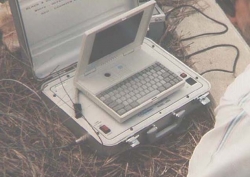Polarization Resistance

Linear polarization resistance (LPR) measurements are used to observe instantaneous corrosion rate. Lawson, et al. (1993) Elias et al. (2009) and Berkovitz and Healy (1997) describe the application of the LPR technique to MSE reinforcements. Polarization resistance measurements require an instrument to generate a plot of potential versus applied current (E versus iapp) for a range of approximately E ±20 mV relative to the free corrosion potential of the reinforcement being monitored. Three electrodes are required to perform the test including working, counter and reference electrodes. The working electrode is the reinforcement being monitored and a nearby reinforcement is used as a counter electrode. The potential at the interface of the working electrode is controlled through current impressed between the working and counter electrodes. A copper/copper sulfate (CSE) electrode serves as a reference electrode to monitor the changing potential of the working electrode. The measured resistance, PR', is actually the sum of the interface and soil resistance (PR' = PR + Rs) and a correction for soil resistance is often necessary.

